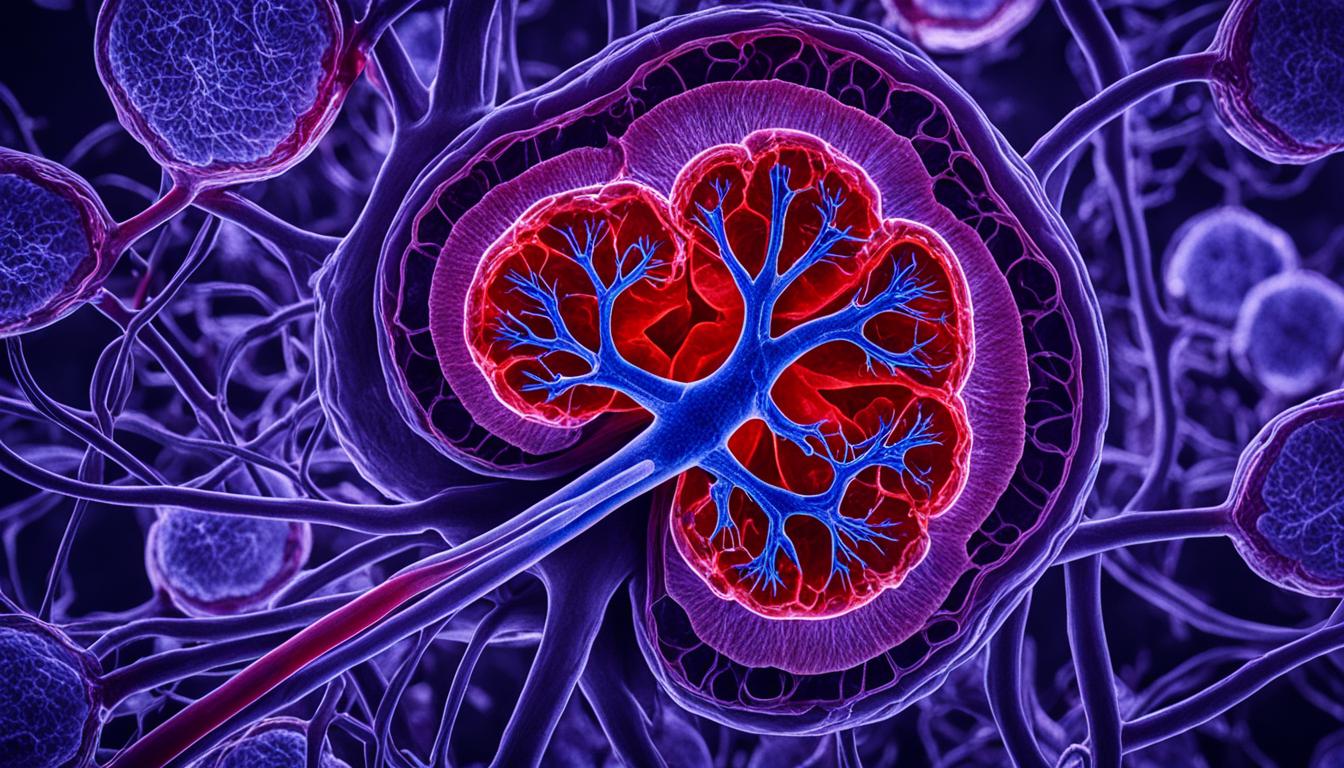Pyelonephritis is a serious kidney infection. If not treated, it can damage the kidneys. Bacteria usually cause it when they move from the urethra or bladder into the kidneys.
Causes of pyelonephritis are often related to infections, like in the urinary tract. Benign prostatic hyperplasia, masses in the abdomen or pelvis, and kidney or bladder stones can also cause it. Those with diabetes or weak immune systems are more likely to get pyelonephritis.
Symptoms of pyelonephritis are fever, blood in the urine, and pain or discomfort during urination. You can also feel pain in the stomach or side. To diagnose it, doctors do a physical exam and tests on your urine and blood. They might also use ultrasounds or CT scans.
Treatment varies by how bad the infection is. Mild cases often need antibiotics. If it’s severe, you might have to go to the hospital. To avoid pyelonephritis, treat urinary infections quickly and keep things clean. Always pee after sex.
Key Takeaways:
- Pyelonephritis is a serious kidney infection caused by bacteria entering the kidneys.
- Common causes of pyelonephritis include urinary tract infections, bladder infections, and cystitis.
- Conditions like benign prostatic hyperplasia, abdominal or pelvic masses, and kidney or bladder stones can also lead to pyelonephritis.
- People with diabetes or weakened immune systems are at a greater risk for pyelonephritis.
- Symptoms of pyelonephritis include fever, blood in the urine, frequent and painful urination, and abdominal or flank pain.
Causes and Risk Factors of Pyelonephritis
Pyelonephritis, a severe kidney infection, happens when bacteria get into the kidneys. This usually comes from infections in the bladder or the urinary tract. Many other health issues can also lead to pyelonephritis. For example, bladder infections, cystitis, and kidney or bladder stones. People with diabetes or weak immune systems are more at risk.
The Role of Urinary Tract Infections
UTIs are a major cause of pyelonephritis. Bacteria from the urethra or bladder can move up to the kidneys and cause an infection. Treating UTIs promptly is crucial to lower the chance of pyelonephritis.
Contributing Factors
Several conditions increase the risk of pyelonephritis. These include bladder infections, cystitis, and benign prostatic hyperplasia. Others like abdominal or pelvic masses and kidney or bladder stones also play a part.
Risk Factors
People with certain health conditions face a higher risk of pyelonephritis. This includes those with diabetes, a weak immune system, and people taking immunosuppressive drugs or living with HIV/AIDS.
In the next section, we will explore the symptoms and diagnosis of pyelonephritis to help you recognize and address this condition.
Symptoms and Diagnosis of Pyelonephritis
Pyelonephritis is a severe kidney infection with several symptoms. Knowing these signs and getting the right diagnosis is key. It helps with quick treatment and stops complications. Symptoms include:
- Fever: High body temperature is common with this infection.
- Blood in the urine: Seeing or finding blood in your urine is a sign.
- Painful urination: Feeling discomfort or a burn when you pee.
- Abdominal or flank pain: Pain in your belly or sides might signal a kidney issue.
If you have these signs, see a doctor as soon as possible. They’ll do a full checkup and may do tests like:
- Urinalysis: Checking a urine sample for bacteria and blood cells.
- Blood tests: Taking blood to see kidney function and signs of infection.
- Imaging tests: Using ultrasound or CT scans to look at the kidneys clearly.
\n
\n
These tests help doctors confirm if you have pyelonephritis. They’re essential to plan the best treatment just for you.
Early Diagnosis for Effective Treatment
Finding pyelonephritis early on is important. It helps avoid serious problems and lessens kidney damage risk. If you notice these symptoms, get medical help right away. A quick diagnosis means you can start antibiotics early.
Waiting to treat pyelonephritis can cause bad health issues like kidney abscesses or sepsis. So, knowing the signs and getting checked is vital.
Stem Cell Therapy for Pyelonephritis and Conclusion
Stem cell therapy’s use in treating pyelonephritis shows a lot of promise. This therapy is part of an exciting field of study. It could change how we treat kidney diseases like pyelonephritis in the future. Patients could see better results because of it.
Pyelonephritis is a severe kidney infection. If not treated, it can cause serious problems. Prompt use of antibiotics and certain preventions can stop or manage it. It’s very important to focus on kidney health and try to avoid pyelonephritis.
While stem cell therapy has its advantages, we need more studies to see its real effects on pyelonephritis. Researchers and doctors are working hard to use stem cells for kidney diseases. They hope these new methods can be a big step forward in treatment.

